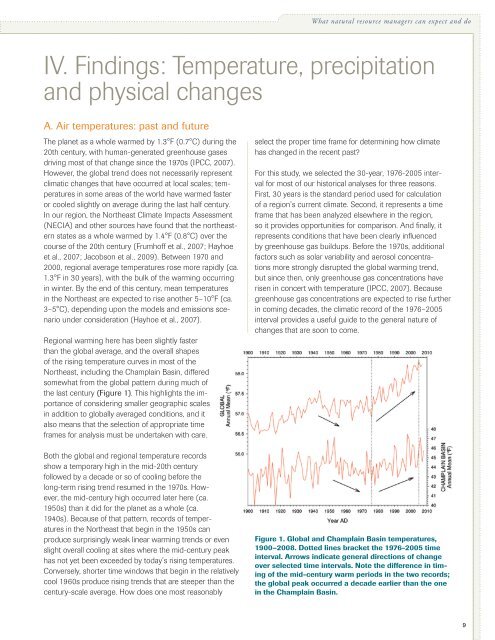Climate Change in the Champlain Basin - The Nature Conservancy
Climate Change in the Champlain Basin - The Nature Conservancy
Climate Change in the Champlain Basin - The Nature Conservancy
You also want an ePaper? Increase the reach of your titles
YUMPU automatically turns print PDFs into web optimized ePapers that Google loves.
What natural resource managers can expect and doIV. F<strong>in</strong>d<strong>in</strong>gs: Temperature, precipitationand physical changesA. Air temperatures: past and future<strong>The</strong> planet as a whole warmed by 1.3°F (0.7°C) dur<strong>in</strong>g <strong>the</strong>20th century, with human-generated greenhouse gasesdriv<strong>in</strong>g most of that change s<strong>in</strong>ce <strong>the</strong> 1970s (IPCC, 2007).However, <strong>the</strong> global trend does not necessarily representclimatic changes that have occurred at local scales; temperatures<strong>in</strong> some areas of <strong>the</strong> world have warmed fasteror cooled slightly on average dur<strong>in</strong>g <strong>the</strong> last half century.In our region, <strong>the</strong> Nor<strong>the</strong>ast <strong>Climate</strong> Impacts Assessment(NECIA) and o<strong>the</strong>r sources have found that <strong>the</strong> nor<strong>the</strong>asternstates as a whole warmed by 1.4°F (0.8°C) over <strong>the</strong>course of <strong>the</strong> 20th century (Frumhoff et al., 2007; Hayhoeet al., 2007; Jacobson et al., 2009). Between 1970 and2000, regional average temperatures rose more rapidly (ca.1.3°F <strong>in</strong> 30 years), with <strong>the</strong> bulk of <strong>the</strong> warm<strong>in</strong>g occurr<strong>in</strong>g<strong>in</strong> w<strong>in</strong>ter. By <strong>the</strong> end of this century, mean temperatures<strong>in</strong> <strong>the</strong> Nor<strong>the</strong>ast are expected to rise ano<strong>the</strong>r 5–10°F (ca.3–5°C), depend<strong>in</strong>g upon <strong>the</strong> models and emissions scenariounder consideration (Hayhoe et al., 2007).Regional warm<strong>in</strong>g here has been slightly fasterthan <strong>the</strong> global average, and <strong>the</strong> overall shapesof <strong>the</strong> ris<strong>in</strong>g temperature curves <strong>in</strong> most of <strong>the</strong>Nor<strong>the</strong>ast, <strong>in</strong>clud<strong>in</strong>g <strong>the</strong> Champla<strong>in</strong> Bas<strong>in</strong>, differedsomewhat from <strong>the</strong> global pattern dur<strong>in</strong>g much of<strong>the</strong> last century (Figure 1). This highlights <strong>the</strong> importanceof consider<strong>in</strong>g smaller geographic scales<strong>in</strong> addition to globally averaged conditions, and italso means that <strong>the</strong> selection of appropriate timeframes for analysis must be undertaken with care.Both <strong>the</strong> global and regional temperature recordsshow a temporary high <strong>in</strong> <strong>the</strong> mid-20th centuryfollowed by a decade or so of cool<strong>in</strong>g before <strong>the</strong>long-term ris<strong>in</strong>g trend resumed <strong>in</strong> <strong>the</strong> 1970s. However,<strong>the</strong> mid-century high occurred later here (ca.1950s) than it did for <strong>the</strong> planet as a whole (ca.1940s). Because of that pattern, records of temperatures<strong>in</strong> <strong>the</strong> Nor<strong>the</strong>ast that beg<strong>in</strong> <strong>in</strong> <strong>the</strong> 1950s canproduce surpris<strong>in</strong>gly weak l<strong>in</strong>ear warm<strong>in</strong>g trends or evenslight overall cool<strong>in</strong>g at sites where <strong>the</strong> mid-century peakhas not yet been exceeded by today’s ris<strong>in</strong>g temperatures.Conversely, shorter time w<strong>in</strong>dows that beg<strong>in</strong> <strong>in</strong> <strong>the</strong> relativelycool 1960s produce ris<strong>in</strong>g trends that are steeper than <strong>the</strong>century-scale average. How does one most reasonablyselect <strong>the</strong> proper time frame for determ<strong>in</strong><strong>in</strong>g how climatehas changed <strong>in</strong> <strong>the</strong> recent past?For this study, we selected <strong>the</strong> 30-year, 1976-2005 <strong>in</strong>tervalfor most of our historical analyses for three reasons.First, 30 years is <strong>the</strong> standard period used for calculationof a region’s current climate. Second, it represents a timeframe that has been analyzed elsewhere <strong>in</strong> <strong>the</strong> region,so it provides opportunities for comparison. And f<strong>in</strong>ally, itrepresents conditions that have been clearly <strong>in</strong>fluencedby greenhouse gas buildups. Before <strong>the</strong> 1970s, additionalfactors such as solar variability and aerosol concentrationsmore strongly disrupted <strong>the</strong> global warm<strong>in</strong>g trend,but s<strong>in</strong>ce <strong>the</strong>n, only greenhouse gas concentrations haverisen <strong>in</strong> concert with temperature (IPCC, 2007). Becausegreenhouse gas concentrations are expected to rise fur<strong>the</strong>r<strong>in</strong> com<strong>in</strong>g decades, <strong>the</strong> climatic record of <strong>the</strong> 1976–2005<strong>in</strong>terval provides a useful guide to <strong>the</strong> general nature ofchanges that are soon to come.Figure 1. Global and Champla<strong>in</strong> Bas<strong>in</strong> temperatures,1900–2008. Dotted l<strong>in</strong>es bracket <strong>the</strong> 1976-2005 time<strong>in</strong>terval. Arrows <strong>in</strong>dicate general directions of changeover selected time <strong>in</strong>tervals. Note <strong>the</strong> difference <strong>in</strong> tim<strong>in</strong>gof <strong>the</strong> mid-century warm periods <strong>in</strong> <strong>the</strong> two records;<strong>the</strong> global peak occurred a decade earlier than <strong>the</strong> one<strong>in</strong> <strong>the</strong> Champla<strong>in</strong> Bas<strong>in</strong>.9
















